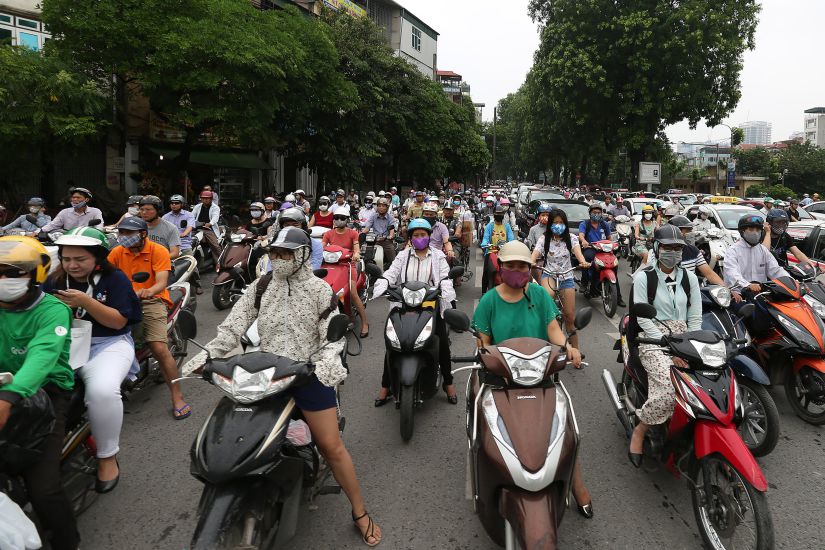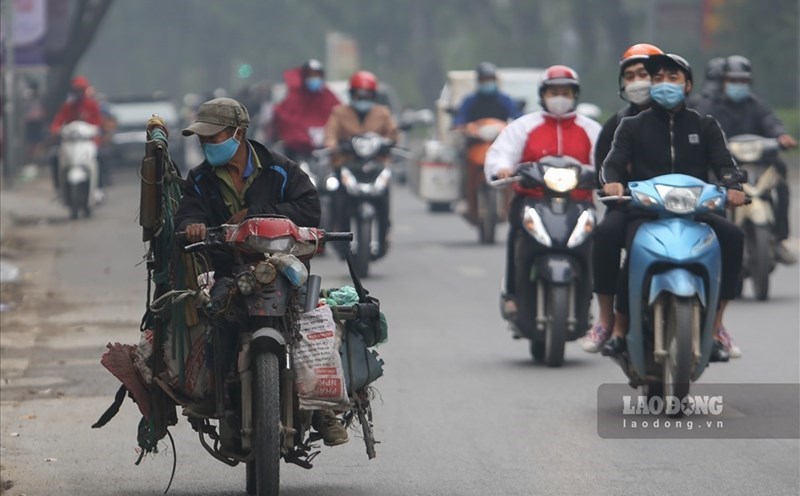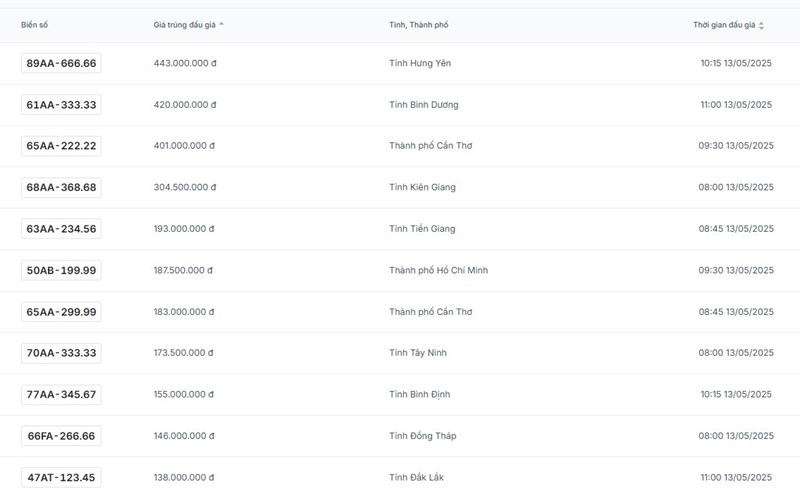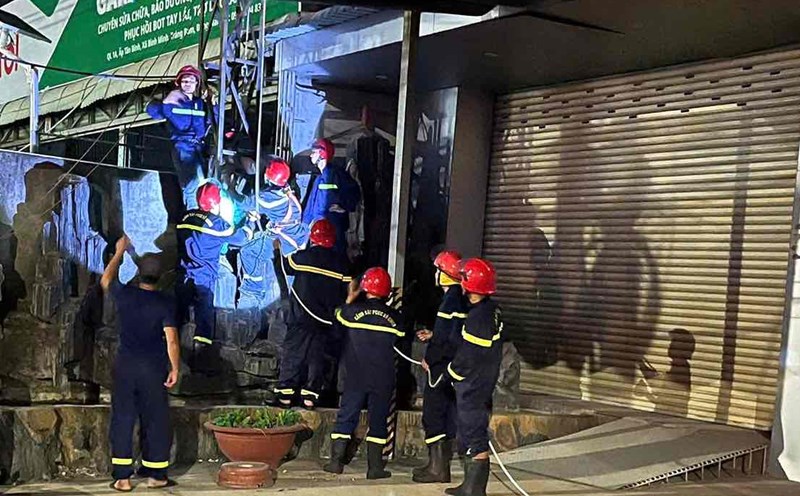Struggling with technical standards regulations
Since 2010, the project to control emissions from motorbikes and mopeds has been approved by the Prime Minister. However, up to now, Vietnam has not been able to control motorbike emissions, many motorbikes that have been around for decades still travel on the streets, posing a potential risk of traffic insecurity and environmental pollution.
According to a report from Hanoi, the whole city has about 9.2 million vehicles of all kinds operating in the area (excluding vehicles of specialized agencies). Of which, the city is managing more than 8 million vehicles of all kinds, including 1.1 million cars and 6.9 million motorbikes, and there are about 1.2 million cars and personal motorbikes from other provinces.
Since 2022, Hanoi has proposed a roadmap for emission inspection for motorbikes aged 5 years or older to limit emissions to the environment and also proposed the establishment of 170 motorbike emission inspection stations at motorbike maintenance centers and stores to inspect emissions for motorbikes aged 5 years or older. However, up to now, Hanoi and Ho Chi Minh City have not yet built this inspection system. The reason is that there are no specific instructions and regulations on this issue.
The roadmap and regulations for motorbike emissions play an important role in environmental protection and improving air quality. However, according to the assessment of the Ministry of Agriculture and Environment: Vietnam still does not have current emission regulations to meet environmental protection requirements.
Currently, only TCVN 6438:2018 is the standard regulating the maximum allowable emission limits for motorbikes and mopeds, but according to the Law on Technical Standards and Regulations, TCVN is only a recommended and voluntary application. Only Vietnamese standards (QCVN) issued by State agencies are legally mandatory.
Up to now, there is no QCVN for emissions of motorbikes and mopeds in circulation in Vietnam, so there is not enough basis to fully implement the provisions of the Law on Environmental Protection, the Law on Road Traffic Order and Safety and the direction of the Prime Minister to soon implement the roadmap to apply the regulations on mandatory emission levels for motorbikes and mopeds in circulation in Vietnam.
In reality, there are only regulations to eliminate homemade vehicles with a lifetime for cars, and there is no mechanism to gradually eliminate old, dilapidated motorbikes and motorbikes with high emissions, leading to the situation where used vehicles continue to circulate, causing more serious pollution.

Proposal for pilot in Hanoi and Ho Chi Minh City from January 1, 2027
The Ministry of Agriculture and Environment is drafting regulations on the roadmap for applying national technical regulations on emissions of motorbikes and mopeds in circulation in Vietnam.
Accordingly, this ministry recommends: Starting to conduct emission inspections of motorbikes and mopeds in circulation from January 1, 2027 for motorbikes and mopeds in circulation in the two centrally-run cities, including Hanoi City and Ho Chi Minh City. For motorbikes, the largest allowable limit on emissions will be applied as prescribed in the National Environmental Technical Regulation on emissions of motorbikes and mopeds in circulation in Vietnam.
From January 1, 2028, it is expected to apply emission inspection for motorbikes and mopeds in circulation in Hai Phong, Da Nang, Can Tho and Thua Thien - Hue similar to the previous phase. From January 1, 2030, the emission inspection of motorbikes and mopeds in circulation nationwide will be applied.
Regarding this proposal, the Ministry of Agriculture and Environment assessed that applying emission standards will improve the quality of the living environment, contribute to protecting public health, especially vulnerable groups (children, the elderly), and improve labor productivity through diseases related to air pollution. Reduce indirect medical costs and economic losses due to diseases related to air pollution (respiratory, cardiovascular...) in the two cities.
This regulation will also contribute to perfecting the legal system on motorbike emission control, specifying the provisions in the Law on Environmental Protection 2020 and the Law on Road Traffic Order and Safety 2024.
In particular, when there are regulations on emission inspection, it will promote and create a foundation for the mechanism of "recovering - recycling used vehicles" towards developing a circular economy, marking efforts in controlling and limiting emissions from motorbikes and mopeds in circulation.
Vietnam is actively and proactively implementing international commitments, especially commitments since COP26 (at COP26, Vietnam committed to and declared to achieve net emissions of 0 by 2050).
The issuance of regulations on motorcycle and motorbike emissions is one of the strong determinations in transitioning to a green and sustainable economy, affirming Vietnam's will and responsibility in the international community, towards a green and sustainable future.
Air pollution in Vietnam has caused damage to 5 - 7% of GDP annually
According to the Ministry of Agriculture and Environment, one of the main causes of air pollution is transportation activities, including the operation of road motor vehicles in circulation. Research results by some environmental experts show that the contribution rate of dust pollution from mobile transportation activities is between 20% and 60%.
World Bank statistics also show that air pollution in Vietnam has caused damage to 5 - 7% of GDP per year.
In addition, according to research by Fulbright University Vietnam, air pollution in our country has caused economic losses of about 9.86 - 12.45 billion USD in 2013 and has increased significantly in recent years.
In Hanoi alone, the estimated cost of respiratory examination and treatment, economic losses due to illness for inner-city residents is 1,500 VND/person/day and the total economic losses due to respiratory diseases are about 2,000 billion VND/year.











